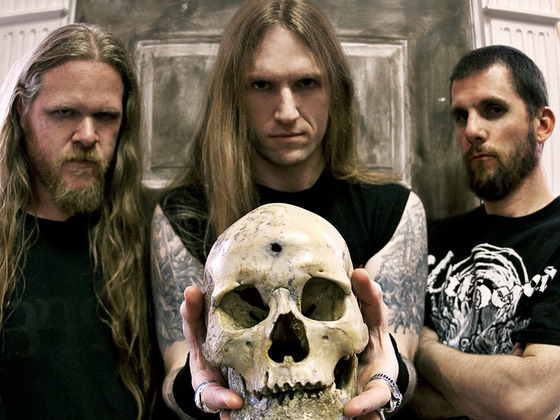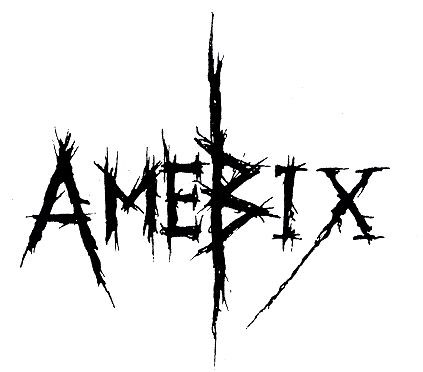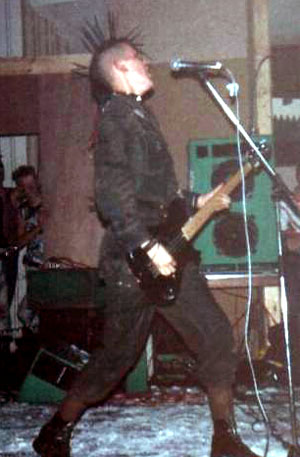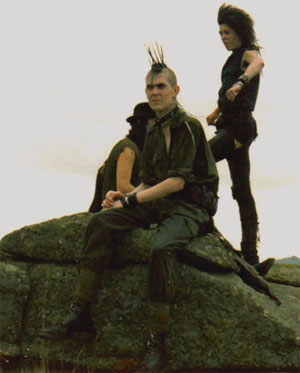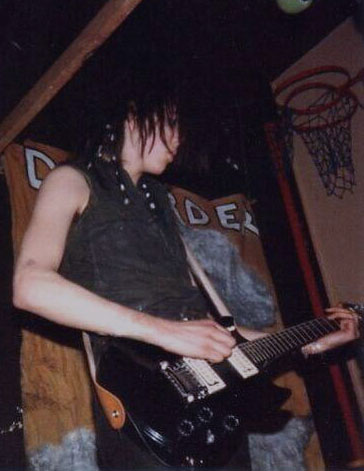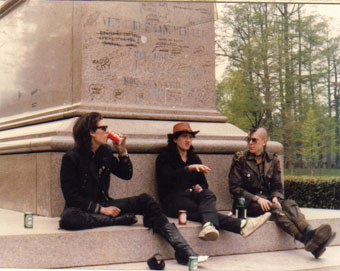Editor’s note: this originally appeared in issue #3 of the zine “voices wake us…” (“Voices Wake Us…” Zine. $1ppd. voiceswakeuszine@hotmail.com) but it can be disseminated freely so long as this notice remains intact.
Questions by “Voices Wake Us…” Zine.
Answers by MkM (vokillz).
First off, what is your name and what part do you play in the band (instrument or vocals, etc.)?
vokalist, disease holder of AntaeuS. Satanik stigmata & preacher of the Void. 27 years old up to this day, non dead to most humans. Frontman & main voice for AntaeuS, I do speak for Him.
Now to the real questions. Black Metal’s legendary “first wave” included so many legendary bands like Mayhem, Darkthrone, and Immortal. Many conclude that the evolution of BM ceased after this period, so what do you think Antaeus’ relation is to the progression of the art? Is it justifiable to be merely more extreme? Can anything be added to the music at this point that has not been done already?
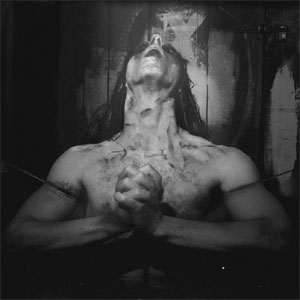 Black Metal does mix both ideology & musick, on this level, I would have to point out that most of nowadays bands have no linkz with the real meaning of this Art.Immortal never really took part of the bm kult, though their sound is very similar, their concept would be more based on northern landscapes, while bands like dark throne & mayhem had a more nihilitic death feels to the lyrikz & the aura was a bit more depressive in most cases.
Black Metal does mix both ideology & musick, on this level, I would have to point out that most of nowadays bands have no linkz with the real meaning of this Art.Immortal never really took part of the bm kult, though their sound is very similar, their concept would be more based on northern landscapes, while bands like dark throne & mayhem had a more nihilitic death feels to the lyrikz & the aura was a bit more depressive in most cases.
We are payin hommage to those bands of the second wave, for their dedication in the early days & the message they did spread. We do evolve in the same vein, we hold the same message & our speech is based on hatred, denial of life & anything that would be related to “holyness” any religions wise, anything “human” related would be a target.
Black metal = SataN in its most strikt vision, we here speak of death, total death & the praise of the vortex that would swallow all. Though the utopia of such an ending is known of us, we do work in this way, spreading our disease & disgust of life and the concept related to it.
Sound wise, we are more extreme than the suscited bands, we couldn’t perform the same of art, for multiple reasons : we do breed violence more than depression (as individuals) & we do perform what we are & breath. The band is composed of 5 individuals more or less evolving on the Hate path. Me & Set being at the forefront of this, & since we are the main composer (him for the music & I being the sole responsible for any lyrikz & propaganda), we are the trademark of AntaeuS.
Also our approach is more destruktive than the “90s” gloomy approach of darkness, while they were opening gates of despair, we are opening gates of torment & pain.
Both are as effective, I truely find my inspiration in both, but violence is our key, our vektor.
Feel his pulse through us.
We are one stone of the edifice.
Black Metal is like a kathedral of Hate, it is not a question of evolution, the “evil”ution within takes place within the rankz of devotee evolving & praising the kult.
You have expressed dissatisfaction with the Cut Your Flesh and Worship Satan album as being too rushed in the studio. To me, I can say I do not think it harms the record and adds to the urgency of the album. However, you have a new album coming out and will this be different and in what way a “representation” of the band that we have not already seen?
Somehow you are right, now that the album is older to my ears (two years or so) I get to listen to it in different perspectives, not rekalling all the shitty detailz about its conception & its spreading.CYFAWS was a gathering of mostly old trackz, like demos & reh tracks, all gathered on the same full lenght. Only one track never appeared anywhere before the cd release (though I am not even too sure about that now, I should check the live tape on chanteloup creations…) also the cd had three different rekording on it, which was a bit messy & made it sound more like a recollection than anything else.
Now, I think that baphomet did allow the band to put all together the most efficient earlier track of the band (inner war, devotee, nihil khaos…) but a rerecording of the whole album would have been best, now that would be the main complain about this lp.
Also this album did cost us a lot of money, but I do not fool myself, it is the same way for many bands around here, still having labels to cash on your work without being fair to the band is something I will never tolerate. That made me freak out, the band never got a fuckin cent out of the sale of the band, considering it did reach around 3000 copies (which is amazing to us, we never expected this much) one could easily guess that we got massively fucked on this one.
DE PRINCIPII EVANGELIKUM the newest release presents a more compact release, being composed on a two years basis, the whole has a more “united” strukture & lyrikz wise, that did allow me to have something fully solid. This time the lyrikz are included, I had the time to type all in time so people will finally get to understand what lies behind antaeus, though it will remain obscure to most or simply fucked up.
DPE is less easy to get into, it took me a few month to get into some trackz myself, having one hell of a hard time to lay vokalz on those & get the whole strukture in the reh’ room
The band does reh’ around 6/7 hours per week in the reh’ room & more when we get nearer to live exp or studio rekording. We get ridd off a lot of material, our work is very serious & we are making sure to have the most efficient offering to the black metal kult.
I think that one thing that would lack on DPE would be the intro sektion that are truely important to me, this time the drummer & I did lack time to meet & do something of my taste, that is my main “negative critic” to the new album. Next release shall see a return to those sonic landscapes & all the frustration that did hide behind those.
Many BM bands are one-person projects (Burzum, Bathory, Taake, Krieg, Ildjarn, eventually Emperor, and at times Darkthrone). What is the band construct of Antaeus? How does the song-writing process work and who does most of the “legwork” for the band, ie: setting up gigs and record-related business. Any comments on past members or development of the band over time?
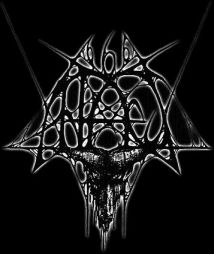
You would mention there strongminded individuals that had one hard time finding the right members to perform their art with, or simply couldn’t deal with others, due to ego conflikts.I was just a session member in the early days, being too busy with my zine & my distribution (& my former band)
When AntaeuS turned into a virus in me, I felt like it had to evolve further than the limitations that the main man back then had for it. I think that all took shape when I got hold of all the strukture of AntaeuS, getting set as main guitarist was the best move ever, since we have known each other for years & we had the same musikal taste (for the early 90s sound, nowadays we tend to listen to different aktz yet our basis are the same).
Drum wise, we decided to get ridd off the drum machine & never changed since.
Bass & rythm guitar wise, we might have had more than 20 different members within the band, but in 98 we did finally find the right one, being also involved in Eternal Majesty with whom we did a split demo back then. I did know them since they were working a lot with SPIKEKULT (since their first demo, “dark empire”).
Since then, the line up is perfekt & all of us are united & work on the musikal struktures.
For all the rest, interviewz, ideals, propaganda, kontaktz, ALL is done by me & me only. Mostly due to the fact that I am the only one speakin & writtin in english.
That does take a lot of my time, due to this I did stop all others implications (my zine, other bands & even spikekult for some months/years).
We do not seek gigs really, since conditions are always fuckin ridiculous or awful, I try to avoid to the max getting to play live, though we had two or three great shows since 94; mostly over the two past years.
Getting gas money & some beers seems to be the VERY best we could get in europe, even if we perform in front of 300 people… the cost to rent a place is so high that none could ever pay the band.
A couple reviews I’ve read of CYFaWS, while positive, have accused the band of not bringing anything new to the table. Stylistically, I would say that Antaeus is a) faster (I’d say only Krieg is as fast), b) more “grind”, c) less atmospheric, d) more brutal and divided into penetrating structures of noise than in an “epic” sense of many bands. Agree? What is the aesthetic you are going for here, other than just “fast.” Because it is definitely a unique and not just a retro sound.
I do agree with those reviewz, still we never did claim to bring anything to new, so I sometimes wonder why we are accused of that, just like we were lyin about it.True, we are faster, though I would use “more brutal” instead, since speed for itself doesn’t mean much to us, tons of swedish bands are playin hyper fast, but both the drumz & riffs are without any effects on the listener.
Brutality & Hate are the main faktors in AntaeuS sound, we do hold this pulse & seek to create such aura within any rekording of ours.
Our epic approach might be linked to the tension we do put in the rekordin process.
The grind aspect cannot be denied as well, musik wise, some bands are truely unique to me, but the message, most of the time, would be simply ridiculous or be the opposite of my ideas.
Older grind bands had more of a dark or sick approach compared to today’s fun/gore/political bands.
Hate is a large concept of the band. Does this reach over into politics at all? Many BM are clearly fascist, a politics based on hate, while others are nihilistic (and in that sense, partially anarchistic). Views of politics in yourself and in the scene?
Hate is anywhere, but most politics would serve some instead of others, while we support the death of ALL; all those fascist bands are always a source of interrogation in my kamp. All those linked to black metal & openly using both the sigils of SataNism & those of Nazism are creating a nonsense to me.the nihilistic part is often dealing with one hope for a brighter future, built on the ashes of nowadays society & values.
I do not have any hope of this kind, the only hope I have is tattooed on my chest.
Let’s go back on the nonsense, I don’t care about NS bands as long as they are not linked with black metal. Politics would limit the initial meaning of black metal.
NSBM seems more serious to the young than the “inverted cross”, since it would represent something more “socially involved”, having to deal with values that would be more “linked” to todays world & having more impact due to the importance of sigils (ie : the use of swastika or SS sigils are full of meaning & related to happening that took place less than a century ago). Politics are giving black metal a more “humanistic” approach, which I don’t really understand. I would understand sadistik exekution using SS symbols or funeral mist for their vision of death in general, but as far as “human values” are involved, I simply don’t get it.
Any individuals mixin bm with ns should realize that there is already a scene for that, anything metal related is more or less viewed as “outcast” due to the code of life (destruktive, alcohol, aggression)…
anyway when I think of those teens doing “sieg heil” here & there with their beers & long hair, they would be among the first to enter the gas kamp that does make me laugh
Death is the main goal anyway.
In what sense is Antaeus a “do it yourself” band that controls the aspects of recording, promotion, management, and production itself? You are clearly dedicated to the underground, but many people are not familiar with the metal underground as much as the more-established and cohesive American punk underground. How does the underground work and how much is Antaeus a separate entity from outside control and influence of labels, promoters, etc?
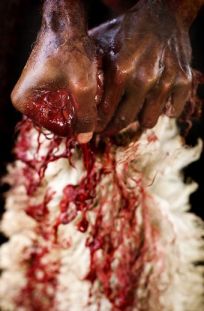
A would be my band then, since I would be responsible for most of those aspects.Being honest, I am not too aware of the punk scene, though got to meet up with some labels from around here pressing punk vinylz & their scene seemed much more “supportive” & less “inner war” in between labels & so on. I might have a wrong of it though.
I would be totally dedicated to one aspect of the ug scene, which I could describe as the only real scene, with true sick freakz & not wannabes & morons of any kind that would pollute the bm kult.
those idiots are numerous & for the past years, I would have spent way too much time on those inbreed fags instead on workin on my code of life & supporting what had to be supported with the scene (bands & labels wise). Now we are viewed as traitors to most, since we did sign to Osmose.
Osmose allows us a studio rekording budget & having the whole distribution in their hand, I could never deal with that myself, my daily job takes around 50 hours per week now (compared to 70 h per week for last year) which makes it nearly impossible to cope with the mail & any correspondance in general. Even reh’ with the band got closed to impossible for me. All is getting better now, but as far as I am concerned, if A didn’t sign to Osmose, all would have stopped. I couldn’t go on paying 300 usd per month for the band, not having enough to cope for my own living cost.
Now we do loose less cash, but we still loose. So when I get to read that we did become fucking rockstars or sell out, I might ask to whom did we sell out???
A band selling 5000 copies (which even ain’t our case) could never live out of it, I am sure that you are aware of that, but many readers out there that did write us do think that we do earn enough money with the band to live with….
It was ok to reply to those questions the first years, but after a while, it killed me that most people wouldn’t get how it workz…
But hell, we are talking about fuckin labels detailz & how bands are getting fucked most of the time
Right now with Osmose, all is doing ok, we just did spend around 400 usd for this one, (lay out & mastering) since we did excess a bit the budget allowed for the studio rekording.
How is the French “scene?” Are there many bands, zines, or venues to play in? Are there a lot of posers?
Scene in france is not my fave subjekt, I did support many bands from around here in the past, being proud of my “local scene”, but all those bands did fuckin backstabb us for no reasons or so. “allies of today are the backstabbers of tomorrow”, thus I don’t mention too much about bands from around here.There is a fair deal of akts though, most of them are amateurish to the core & spending more time in front of camera or doing shirtz than working on the musikal parts.
All of them are envious little morons who are offended when they realize it is not that “easy” to have a cd out. They all think that demos are useless & that the underground is just a chat room on the net.
For the older ones, we had either conflikts with them or totally different views.
Apart from a few dozen individual in the whole france, we don’t get along too much with individuals from around here.
I had my fair deal of war around here.
In the newer band ; dark opus & aosoth are among my faves
DEATHSPELL OMEGA must be the ultimate black metal band the traditionnal way. END ALL LIFE is without any doubt the best vinyl bm label, they must have by now the CYFAWS on lp out, & that is one Honour for us to be on that label.
Zines? well 666 is the best in the extreme bm/dm way, eternal fire was killer too but defunct (or simply no newz from them since long), stregoica was kult in its dayz, now they are doing ordealis rekords which is very promising (killer work from their part), deadfuckinchurch is a good zine but he said that his final issue will be the next…
Some distro are great too, like paleur mortelle & warchangel.
AntaeuS will have a split 10″ with AOSOTH on Paleur Mortelle (akhaeus@aol.com) in the comin month btw.
Gigs wise, the audience is way better than any us gigs that I got to visit (& I had my fair deal of us deals over the three or four stayz I did over there), we usually get from 150 to 400 nowadays, but places are not so numerous & each venues does cost around 2000 to 3000 usd to rent for a night, with such prices, no bands would get any payment, asking for gas payment is already a dream for bands.
Due to that, in 2001, antaeus only performed live Once.
We did perform a bit more over the past months, with bands like nargaroth, taake, enthroned, eternal majesty…
The last hellish gig we did do was in Paris with taake & enthroned, our best set ever since 2001
In nov 002 we will be among the opening bands for the DEICIDE european tour, we shall desecrate new countries & I do expekt that tour I must say.
It’s nothing you’d understand, but I do have something to say. In fact, I have a lot to say, but now is not the time or place. I don’t know why I’m wasting my time or breath. But what the hell? As for what is said of my life, there have been lies in the past and there will be lies in the future. I don’t believe in the hypocritical, moralistic dogma of this so-called civilized society. I need not look beyond this room to see all the liars, haters, the killers, the crooks, the paranoid cowards — truly trematodes of the Earth, each one in his own legal profession. You maggots make me sick — hypocrites one and all. And no one knows that better than those who kill for policy, clandestinely or openly, as do the governments of the world, which kill in the name of God and country or for whatever reason they deem appropriate. I don’t need to hear all of society’s rationalizations, I’ve heard them all before and the fact remains that what is, is. You don’t understand me. You are not expected to. You are not capable of it. I am beyond your experience. I am beyond good and evil, Legions of the night — night breed — repeat not the errors of the Night Prowler and show no mercy. I will be avenged. Lucifer dwells within us all. That’s it.
– Richard Ramirez
Most BM has diverged into “symphonic,” commercial crap. I’m sure you have some ventings on bands like this (Dimmu Borgir, Anorexia Nervosa, Ancient), or on “retro” bands like Dark Funeral. To many, Black Metal must remain underground and elite, and yet within it are elements that are more palatable to the masses- a band like Immortal proving that BM can be commodified over time. Thoughts on this phenomenon in Black Metal?
Like anywhere, when you get an artistic style that would be perceived as elitist & underground, one will have the wish to “extand” it on a different level, for various reasons.Some considers that the message should not be limited to one handful of individuals
some seems to think that they would sell more rekords having an “evil” image Some just find it “cool” to use such imagery Others are living the black metal kult, on a daily basis.
Music wise, I am closed minded when it comes to black metal, not opening myself too much to new genres, though I did try to pay attention to all those bands poppin up & crossing goth, indus & so on with black metal.
I must admit that diabolicum & mysticum were the only one that did match my expektations when it comes to the aura created.
On the other level, I also pay attention to the “performers”, for example : Anorexia Nervosa is often quoted as fag band, mostly due to the COF sounding of the musick. But on a personal level, the frontman is really a sicko & is among those few individuals I consider. Yet he would be a bit too much “rock n roll” sometimes eh too much drugz & autodestruction for me (which does provide a smile, that does you an idea on how fucked the man can be) aktually I think that when you get to meet him, he would be more in his place belongin to sadistik exekution than anorexia (musick wise) Ancient & dimmu borgir never made it to me, not even one track from their early days (the ep of ancient was ok though).
You did qualify some elements of black metal as “palatable” for the masses, yet we have to redefine masses then, since those masses would be the “extreme metal scene” which is not that wide, only a few thousands people I would say.
Not something that could be play on the air of any local radio show & musical tv shows or whatever. We are not dealing with “pop” music. But I do agree, black metal did sadly evolve to a wider audience & that doesn’t mean that the real audience did grow bigger, just that it did expand to people that simply don’t get a clue of what real black metal is about.
Having some individuals to compare napalm death to dark throne amazes me… the only link between those bands is mostly in the instruments used & some beats. (& some would kill me for the “rythm” comparaison)
Anyway, on our level, like other bands, we remain an underground band, you will most likely always find “cyfaws” & “dpe” on cd format, but we will go on doing limited tapes & vinylz. Only for those few sick ones that are also the pulse of the band.
It does mean a lot to us to be supported by like minded individuals, band members or zine editors or just listeners.
I do not get much letters in that vein, but with those few with whom we share visions, getting to read some comments on AntaeuS work is always rewarding.
Our satanik audio violence would be a weapon & only some individuals know how to handle it & how to view it properly.
Carcass or Bolt Thrower? Pick one.
Fuck… Bolt Thrower
at least they didn’t change & “cenotaph” is an instant classic for me, such as the “in the battle there is no law” lp. carcass had amazing trackz but fuckin wimped out too much for my taste.
When can we expect the new album (on Osmose, right?) and will there ever be an American tour??
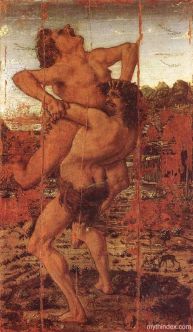
the new rekordin shall be out on sept 23rd in europe, so obviously a bit later in the usa, osmose doesn’t have a distributor over there I think, so most releases are available mostly through ug mailorders & so on. I doubt one will find it as easily as CYFAWS over there. I seriously doubt on the american tour thing, though I wish we could go over there & perform with bands like black witchery, thornspawn, krieg, demoncy, gbk & so on. Since we are doing a european tour for “DPE” in november, as opening band for Deicide, I am not nearly sure that no tour will happen until the next release (the third album that is).Having us on a european tour would mean getting the band on a bigger “bill”, having an headlining band that could make it possible. As of now, I have no big expectation about a us tour, since it seems nearly impossible, we are not “selling” enough to be pushed that way.
The Deicide tour is already something really expensive.
In the future, who knowz? but I wouldn’t be surprised if the band never gets to perform over there.
Bands like marduk, satyricon & others took forever to go to the other continent & most of the time, itz like a money vortex more than anything else.
Time shall tell, we still have to perform over here first, that is our territory & we haven’t visited more than three countries as of now (which would be like performin in three different states for a us bands).
To you, what is most important in sustaining black Metal into the coming years, as it is increasingly an “endangered” form of music?
I see it that way : Evil will never dies, it might change shape, as long as some form of Art will be dedicated to its “grandeur”, I see no problem with itBlack Metal has somehow a more raw approach to it, a darker incarnation meant to appeal to more extreme masses, thus a minority of individuals are truely meant to understand fully the concept behind this genre.
Black metal is nowadays marketed as a musical genre only, with gimmicks to help the sales. Many bands did take the opportunity to rise using those “eye catching” ideas related to black metal.
Your top 5 BM records?
DarkThrone “a blaze in the northern sky”
Funeral Mist “devilry”
Katharsis “666” + “red eye of wrath” demo
Blasphemy “fallen angel of doom”
Beherit “D. down the moon” (& oath of the black blood)those are the ultimategettin near to that, I’d add sadistik exekution (all releases), profanatica, demoncy, krieg… I’d easily give 20 names that would represent the whole list of bands I really support…. Giving 30 names would be impossible though. not enough bands have individuals matchin the right ideology one should have within the bm scene.
Thanks for the interview! Good luck on your upcoming record and in the inevitable Satanic victory over the forces of light. Have a nice day
Forces of Light are forces of lies as well, they are their own failure & we shall be the witness & the temptation for them.Take a look in the abyss & the abyss will stare back at you
For we hold the ultimate void, we shall go on, we are Omega.
No Comments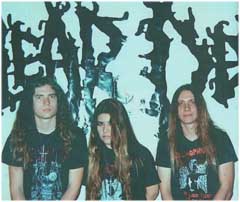 What art do you enjoy outside of metal?
What art do you enjoy outside of metal?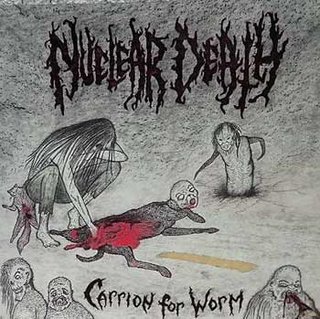 If you were suspended in a reality where another Nuclear Death album might be made, what in your mind might it sound like?
If you were suspended in a reality where another Nuclear Death album might be made, what in your mind might it sound like? Are you a large fan of any mainstream media?
Are you a large fan of any mainstream media?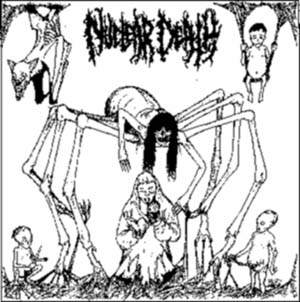 Is Saddam Hussein a CIA plant?
Is Saddam Hussein a CIA plant?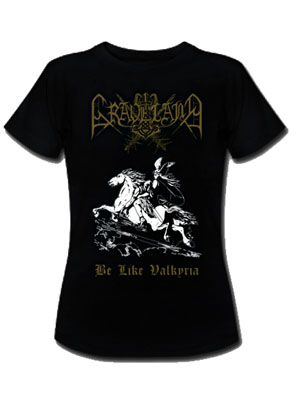
 Black Metal does mix both ideology & musick, on this level, I would have to point out that most of nowadays bands have no linkz with the real meaning of this Art.Immortal never really took part of the bm kult, though their sound is very similar, their concept would be more based on northern landscapes, while bands like dark throne & mayhem had a more nihilitic death feels to the lyrikz & the aura was a bit more depressive in most cases.
Black Metal does mix both ideology & musick, on this level, I would have to point out that most of nowadays bands have no linkz with the real meaning of this Art.Immortal never really took part of the bm kult, though their sound is very similar, their concept would be more based on northern landscapes, while bands like dark throne & mayhem had a more nihilitic death feels to the lyrikz & the aura was a bit more depressive in most cases.


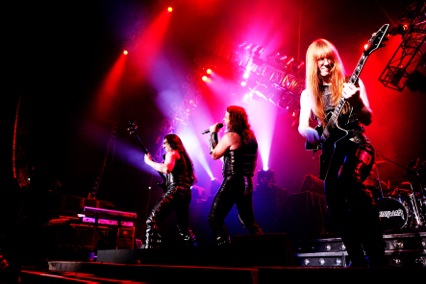 MANOWAR’s new studio album, The Lord Of Steel, will first be released worldwide on June 16, 2012 exclusively on iTunes and on the band’s own online store,
MANOWAR’s new studio album, The Lord Of Steel, will first be released worldwide on June 16, 2012 exclusively on iTunes and on the band’s own online store, 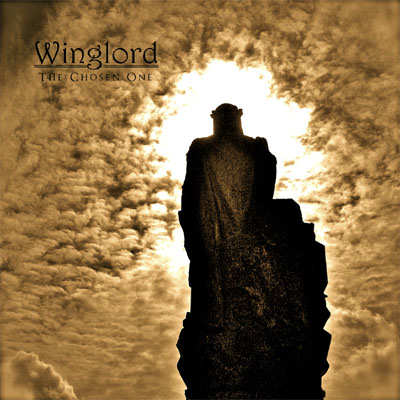 I am calling this new genre post-black-metal. It is the spirit and mood of black metal, the rhythms of 1980s EBM and industrial, the samples and collage technique of martial industrial, the atmosphere of neofolk, the sweeping epic point of view of soundtracks, and that sense of world music evoking the spirit of ancient tribalist folk songs from Europe that Dead Can Dance had going. Mix all this together, and you get a new genre which has a few members such as Kreuzweg Ost, later Burzum, Arcana, Lord Wind and even the Beherit ambient albums.
I am calling this new genre post-black-metal. It is the spirit and mood of black metal, the rhythms of 1980s EBM and industrial, the samples and collage technique of martial industrial, the atmosphere of neofolk, the sweeping epic point of view of soundtracks, and that sense of world music evoking the spirit of ancient tribalist folk songs from Europe that Dead Can Dance had going. Mix all this together, and you get a new genre which has a few members such as Kreuzweg Ost, later Burzum, Arcana, Lord Wind and even the Beherit ambient albums.